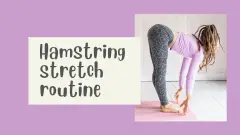If you have tight leg muscles and you want to improve your flexibility, you need to start with stretches that are easy to get into position for, that don’t over-challenge your current level of flexibility and which focus on one muscle group at a time. Trying to get your body into difficult positions that require flexibility in multiple areas isn’t a good way to start. The routine below contains 6 simple beginner leg stretches that can all be done from a standing position and focus on one muscle group at a time.
What is flexibility?
As we move, our muscles continually change length. The maximum length they can extend to is what determines the limit of our range of movement. If your muscles are flexible this means they have a maximum length that allows a good range of movement. If they’re tight, they have a shorter maximum length which is limiting your movement. The good news is that the maximum length can be increased by regular stretching.
Beginner leg stretches
#1 Calf stretch
Our calf muscles are the bulky ones at the back of our lower legs. They work hard pushing our back leg off the ground when we’re walking and running. The Achilles tendon is at the end of the calf muscle and tight calves increase the risk of injury to the tendon. Tightness in the calves can also cause discomfort and lead to injury in the calf muscle itself. Wearing high heels is a common cause of calf tightness, because the shape of the shoe forces the muscle into a shortened position.
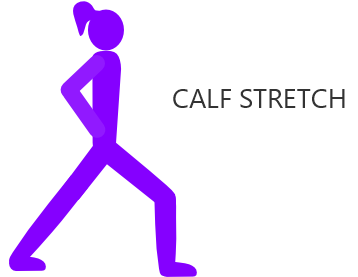
- Stand with your feet pointing forwards, about hip distance apart, front knee bent and back leg straight.
- Press your back heel into the floor to feel the stretch on your back calf.
- Hold for 30 seconds then change legs.
#2 Hip flexor stretch
The hip flexors are at the front of your thigh, attaching to your pelvis, lower back and thigh bone. Tight hip flexors pull the pelvis forwards and are a factor in a set of inter-connected problems that include poor abdominal tone and weak glutes (butt muscles). If you have tight hip flexors you may not be aware – tightness in the hip flexors doesn’t necessarily feel uncomfortable.
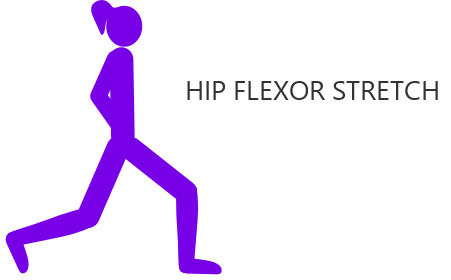
- The start position is similar to the calf stretch above, except the back foot isn’t as far behind.
- Bend your back knee and lift your back heel, as you push your hips forwards to feel the stretch on the hip flexors of the back leg.
- Hold for 30 seconds then change legs.
#3 Hamstring stretch
The hamstrings are at the back of your thigh and are often very tight. This causes discomfort and restricted movement.

- Rest one foot on a chair or bench and straighten your leg out, making sure you don’t push your knee backwards.
- Lean your upper body over your leg until you feel the stretch.
- Hold for 30 seconds then change legs.
#4 Inner thigh stretch
The inner thigh muscles need to be able to lengthen to allow our legs to move sideways. Although we don’t use this movement a lot in everyday life, tight inner thigh muscles are easily strained (groin strain) if we do make a sudden or large sideways movement. In sport and fitness activities, tight inner thigh muscles are a common cause of injury.
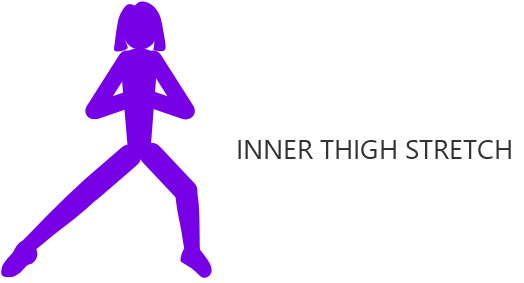
- Take your feet as wide as is comfortable and point them outwards.
- Bend your right knee, shifting your weight towards the right, so that you feel a stretch along your left inner thigh.
- Hold for 30 seconds then change legs.
#5 IT band stretch
The iliotibial band is a long tendon that runs down the outside of your thigh and stabilises your knee. Tightness causes various problems, particularly hip and knee pain. Runners often experience problems associated with tightness in the IT band.
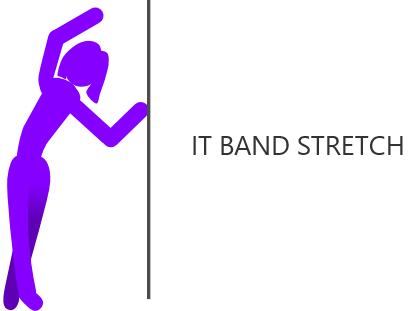
- Stand a bit closer than arm’s length from a wall, with your right hand on the wall for support.
- Cross your left leg in front of your right.
- Lean your upper body towards the wall, stretching your left arm over your head.
- Hold for 30 seconds, then turn around to face the other way and repeat on the other side.
#6 Quad stretch
The quads are a set of powerful muscles at the front of your thigh. Tightness in your quads can cause knee problems. The longest of the four quad muscles also acts as a hip flexor and tightness here can cause pelvic alignment problems, as with tightness in the main hip flexor muscles.
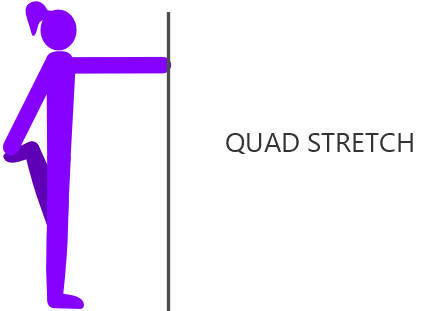
- Stand facing the wall at arm’s length, with your right arm straight and your hand on the wall for support.
- Bend your left knee and take hold of your left foot with your left hand, making sure you don’t bend at your waist.
- Push your hips forward a little, until you feel the stretch in your left thigh.
- Hold for 30 seconds and then change sides.
Notes on this workout
- Your muscles should be warm before you do this workout. If you’re warm from general activity (for example cleaning or gardening), then that’s fine. If not, then do this short warm up.
- For stretch no. 3 you’ll need a chair or bench to rest your foot on. Make sure that you put it somewhere where it won’t slip – against a wall for example.
- Hold all stretches for 30 seconds.
- Stretching shouldn’t be uncomfortable. Take muscles to the point where you feel resistance and then hold it there. Don’t try to force your muscles to stretch further as you might strain them. As your flexibility improves, you will be able to go further before you feel the resistance.
- Make sure you’re wearing clothing that allows you to stretch freely. You should do the stretches barefoot or in flat footwear that is not going to slip on whatever surface you’re using.
- Do the stretches daily if possible, or if not do them as often as you can.
